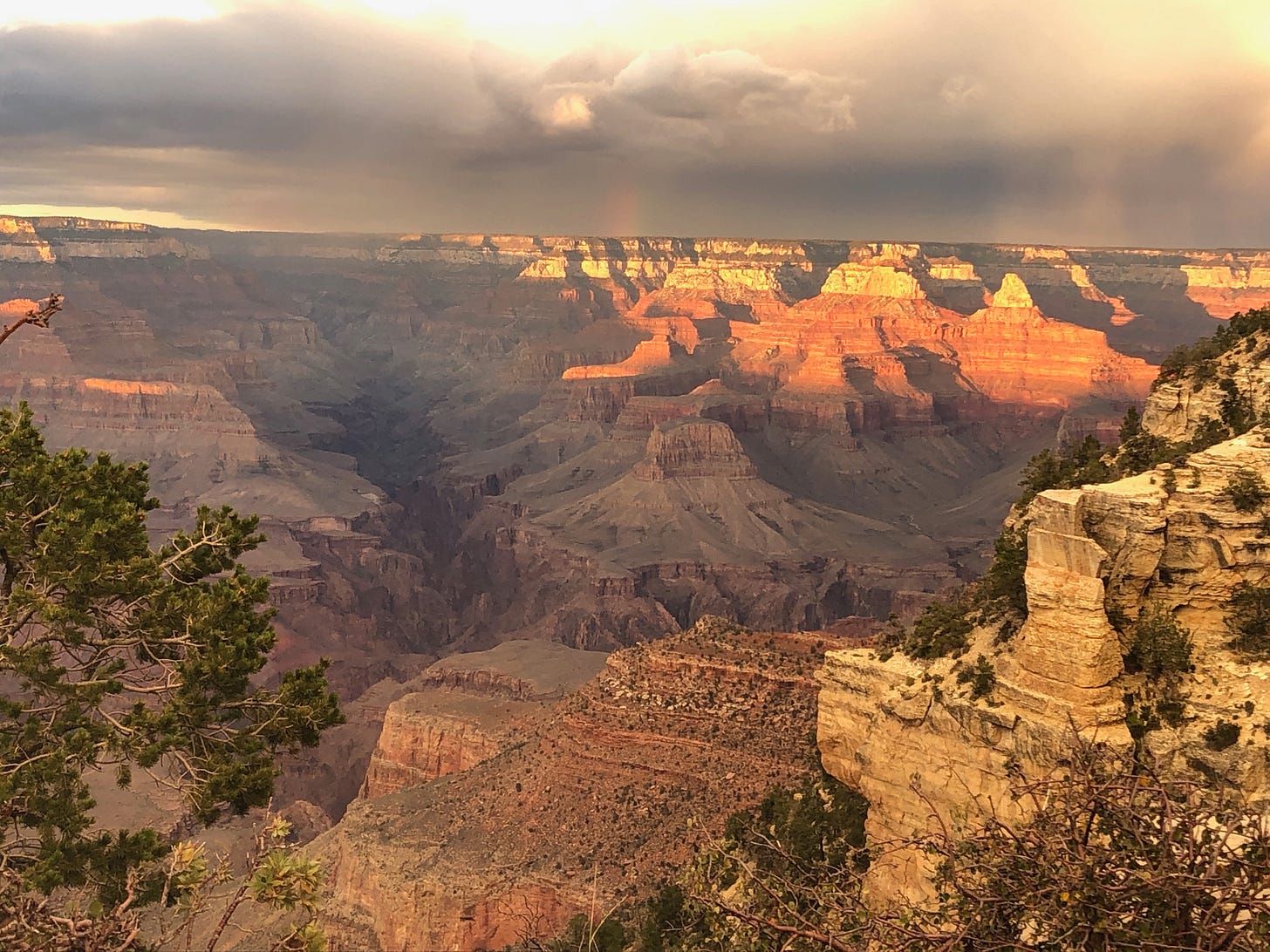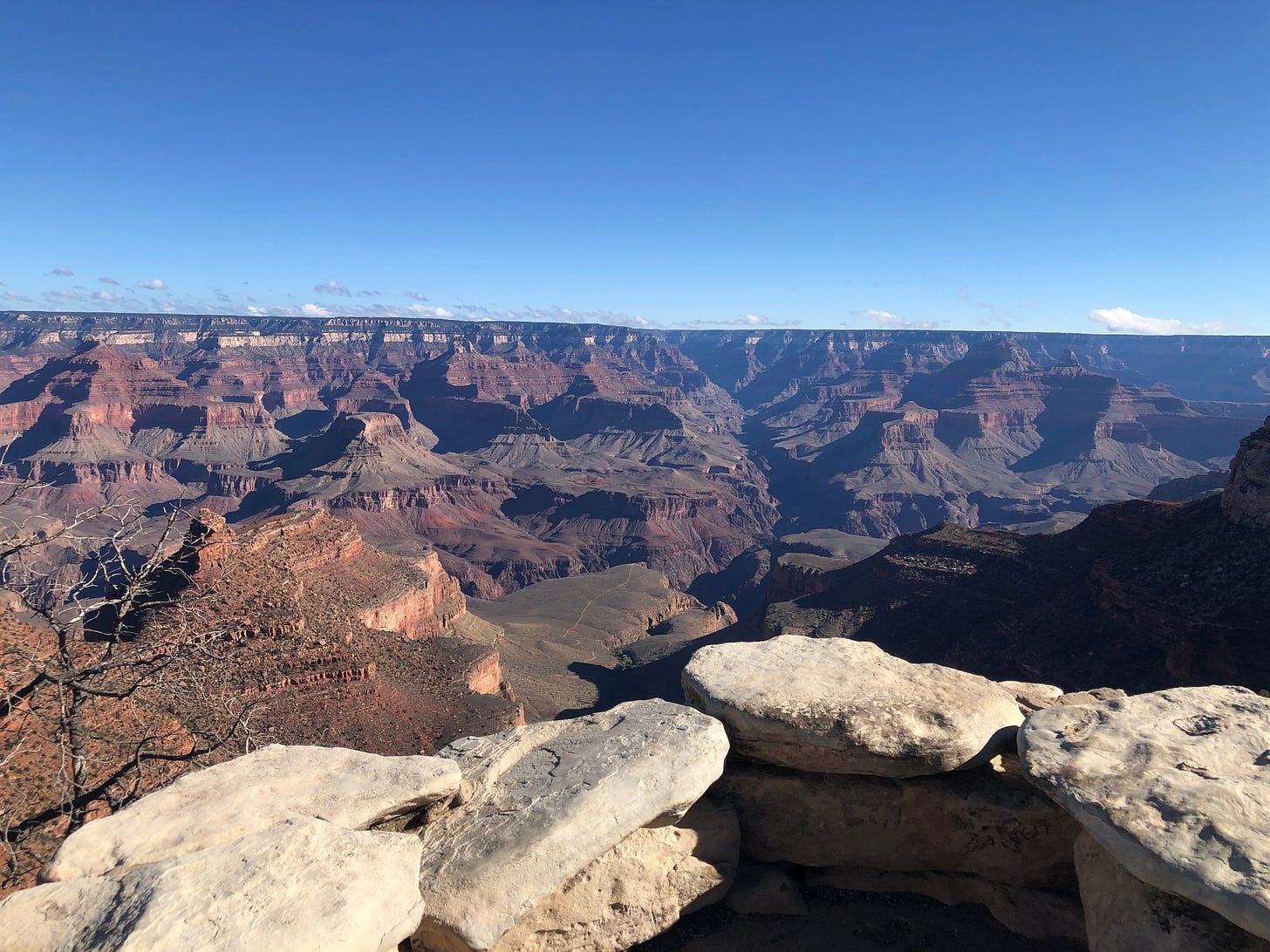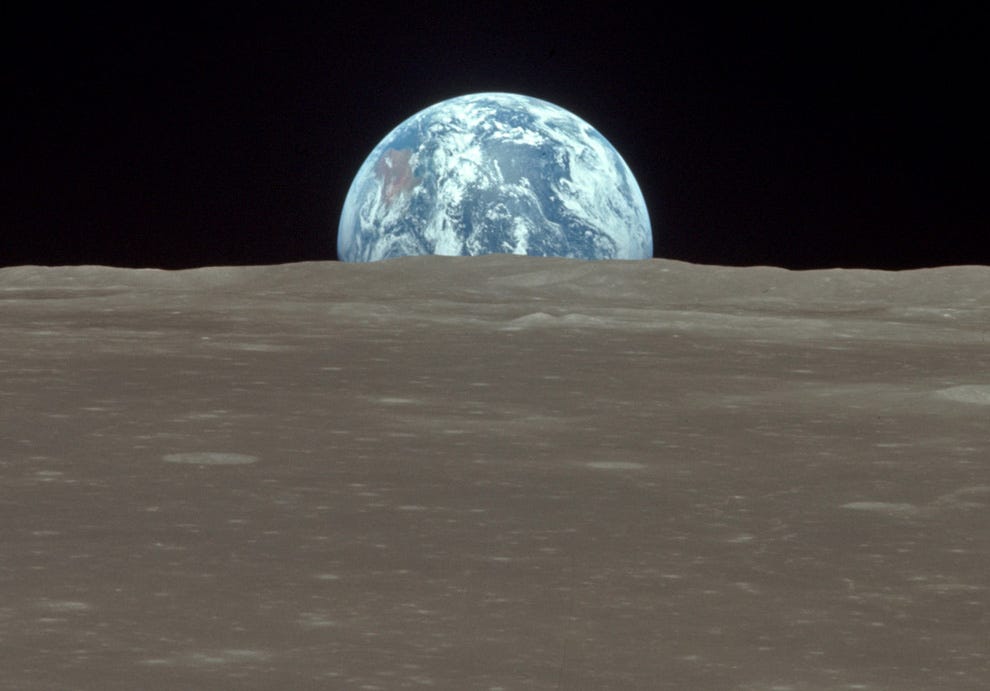
“You look around and you see a world that is impenetrable, that cannot be made sense of. You can either raise your fist, or you say, ‘Hallelujah.’”
— Leonard Cohen
When I first saw the Grand Canyon last October, I was surprised at how emotional I felt. Rafael and I stopped there briefly on our EV road trip and got a hotel room a five-minute walk away. The area was nice and woodsy, but there was nothing to hint at the marvel of nature so close to us. It’s not like when you see mountains as you drive up to them. When we took the short walk to the Grand Canyon rim and caught our first glimpse of it — my first ever — I was moved to tears. I’d had no idea that would happen.
Though our less-than-24-hour stay there was a blip on our 12-day road trip, the Grand Canyon visit was the highlight that made the whole trip worth taking. Feeling that kind of awe and wonder fills us in a way that nothing else can.
Lately, I haven’t been feeling much awe or wonder. When that happens, everything goes haywire. It’s hard to feel good.
We humans need to feel these feelings. To quote Joseph Campbell, as I have before: “Awe is what moves us forward. We live in the stars, and we are finally moved by awe to our greatest adventures.”
But awe can be elusive, and it’s notoriously hard to talk about — or write about. I was reminded of this when my book group recently read the book Awe: The New Science of Everyday Wonder and How It Can Transform Your Life by Dacher Keltner. I was hoping it would help inspire feelings of awe, because I was needing more of those in my life. But while the book gives a good overview of what awe is all about, it didn’t do the trick. Awe is hard to describe, and reading about it might be informative but doesn’t elicit the feeling.
We know it when we feel it. I felt it at the Grand Canyon, and I felt it recently watching the Leonard Cohen documentary Hallelujah. I felt it the night in April 1997 when I stopped at the Nicasio Reservoir on the way home from Point Reyes just in time to see both a lunar eclipse and the mundanely named but awesome Comet Hale-Bopp, which even in San Francisco filled up half the night sky. I felt it as a child when I was lucky enough to visit the Alps, and when I witnessed kittens being born.
Nature, music, and works of art can inspire awe, as can rituals and collective activities like singing and dancing. One of the primary purposes of religion is to inspire awe. Some people get it through meditation. Psychedelic journeys provide a shortcut — again, one that is hard to describe.
Awe has only been studied by psychologists for about 20 years, and they still haven’t figured out much about it. But they can tell us what inspires awe in humans, how that varies among cultures, and the positive effects of feeling awe.
Awe researchers Dacher Keltner and Jonathan Haidt say that an experience of awe involves both perceived vastness, “anything that is experienced as being much larger than the self, or the self’s ordinary level of experience” (whether large or small in actual size), and accommodation, or the “process of adjusting mental structures that cannot assimilate a new experience.” That makes sense.
This video on perspectives, showing both large and small perceived vastness, inspires awe (I like how it calls out some solar panels near the beginning!):
But researchers don’t really know how or why awe evolved, and many of their theories sound a bit off to me. One is that awe gives us reverence for leaders in our group, maintaining social hierarchies. Another is that awe-inspiring vistas allowed us to easily view approaching predators.
More plausible to me are these ideas: Awe could help us adapt to new things by shaking us out of what we expect. And its tendency to take us out of ourselves may have been adaptive to living in social groups.
Some people believe that other social animals also feel awe. Here’s Jane Goodall’s take on chimps:
The Grand Canyon comes up often in discussions of awe, making me feel rather cliché. But hey, I’m only human. Nature is a top awe elicitor, especially for people in the U.S. Again, cliché. Nature-inspired awe can include scary stuff, like tornadoes. Religious and spiritual experiences are also high on the awe list. This famous view of Earth from the moon elicits awe even in those of us who haven’t traveled into space and seen it with our own eyes:
Keltner has categorized the elicitors of awe into what he calls the “eight wonders of life”: moral beauty, nature, collective effervescence (like what you feel dancing or singing with a group), music, visual design, spirituality, big ideas, and birth and death. I’m not sure why poetry isn’t on this list; I’d consolidate literature with music and visual design into a broader arts category.
Awe can have positive cognitive and emotional effects, and it can even be anti-inflammatory and increase oxytocin. Awe can encourage people to think more critically. Awe can encourage humility, and it can inspire altruism as well as being elicited by altruism. It can improve our mood and our sense of well-being. It can decrease feelings of materialism and increase our satisfaction with life. Feeling awe increases our sense of connection, both to other humans and to the rest of the world.
Awe can be transformative.
Keltner ends his book with the observation that “awe integrates us into the systems of life.” Maybe that’s really its purpose and origin. The experience of awe, he says, “connects our individual selves with the vast forces of life.”
We’re in dire need of awe in our current troubling times. Awe takes us out of the mundane in our lives and gives us perspective on the not-so-mundane difficulties of life, reminding us that we’re all connected and part of something bigger. It takes us out of ourselves. It’s the key to our own well-being and that of our planet.
We could probably use shamans to guide us. Anthropologist Jeremy Narby describes shamanism as “a conversation with all the living beings around us, and recognizing the kinship we have with them, and identifying with them sufficiently to see that they have a point of view.”
Psychedelic journeys, especially when guided by a shaman or other guide, can remind us of our connection — to one another, nature, and everything. They’re not for everyone, but we can all avail ourselves of other passports to awe like nature, music, art, communal singing and dancing, spirituality in some form or another.
The trick is to find “everyday awe,” as Keltner calls it. I admit I tend to seek out bigger, more intense feelings of awe. But maybe finding awe can become a practice. Maybe if we look for it in our everyday experiences, we’re more likely to find it — and to enjoy its many benefits.
How do you find awe in your life? Let me know in the comments!









"All people, no matter who they are, all wish they'd appreciated life more." -- David Bowie, from the quasi-biopic Moonage Daydream.
I can relate to so much of what you write here, Rosana. I felt the same way the first time I saw the Grand Canyon. When you come up to Mather Point from the parking lot you don't see the canyon until you get to the rise just before the observation deck. I burst into tears when I saw it, and no pictures could ever do it justice. It's pure magic, especially at sunset. I've been there four times now and every time it's as if I'm experiencing it for the first time.
The observations about 'awe' are fascinating. It's in our DNA, I think. What would we be without it? That may be where AI fails. It can never feel it.